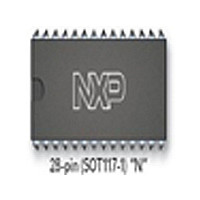SJA1000 NXP Semiconductors, SJA1000 Datasheet - Page 18

SJA1000
Manufacturer Part Number
SJA1000
Description
Manufacturer
NXP Semiconductors
Datasheet
1.SJA1000.pdf
(68 pages)
Specifications of SJA1000
Data Rate
1000Kbps
Number Of Transceivers
1
Power Down Mode
Sleep
Standard Supported
CAN 2.0B
Operating Supply Voltage (max)
5.5V
Operating Supply Voltage (typ)
5V
Operating Supply Voltage (min)
4.5V
Package Type
PDIP
Supply Current
15mA
Operating Temperature (max)
125C
Operating Temperature (min)
-40C
Operating Temperature Classification
Automotive
Mounting
Through Hole
Pin Count
28
Lead Free Status / RoHS Status
Compliant
Available stocks
Company
Part Number
Manufacturer
Quantity
Price
Part Number:
SJA1000
Manufacturer:
PHILIPS/飞利浦
Quantity:
20 000
Company:
Part Number:
SJA1000N
Manufacturer:
NXP
Quantity:
5 510
Part Number:
SJA1000N
Manufacturer:
PHILIPS/飞利浦
Quantity:
20 000
Part Number:
SJA1000T
Manufacturer:
NXP
Quantity:
20 000
Part Number:
SJA1000T SJ
Manufacturer:
NXP/恩智浦
Quantity:
20 000
Part Number:
SJA1000T/N1
Manufacturer:
NXP/恩智浦
Quantity:
20 000
Company:
Part Number:
SJA1000T/N1,118
Manufacturer:
XILINX
Quantity:
125
Philips Semiconductors
6.3.7
The global layout of the transmit buffer is shown in Table 7. The buffer serves to store a message from the microcontroller
to be transmitted by the SJA1000. It is subdivided into a descriptor and data field. The transmit buffer can be written to
and read out by the microcontroller in operating mode only. In reset mode a ‘FFH’ is reflected for all bytes.
Table 7 Layout of transmit buffer
6.3.7.1
The identifier consists of 11 bits (ID.10 to ID.0). ID.10 is
the most significant bit, which is transmitted first on the bus
during the arbitration process. The identifier acts as the
message’s name. It is used in a receiver for acceptance
filtering and also determining the bus access priority
during the arbitration process. The lower the binary value
of the identifier the higher the priority. This is due to a
larger number of leading dominant bits during arbitration.
6.3.7.2
If this bit is set, a remote frame will be transmitted via the
bus. This means that no data bytes are included within this
frame. Nevertheless, it is necessary to specify the correct
data length code which depends on the corresponding
data frame with the same identifier coding.
If the RTR bit is not set, a data frame will be sent including
the number of data bytes as specified by the data length
code.
6.3.7.3
The number of bytes in the data field of a message is
coded by the data length code. At the start of a remote
frame transmission the data length code is not considered
due to the RTR bit being at logic 1 (remote). This forces
the number of transmitted/received data bytes to be
logic 0. Nevertheless, the data length code must be
2000 Jan 04
ADDRESS
Stand-alone CAN controller
CAN
10
11
12
13
14
15
16
17
18
19
T
RANSMIT BUFFER LAYOUT
Identifier (ID)
Remote Transmission Request (RTR)
Data Length Code (DLC)
descriptor identifier byte 1
data
FIELD
identifier byte 2
TX data 1
TX data 2
TX data 3
TX data 4
TX data 5
TX data 6
TX data 7
TX data 8
NAME
ID.10
ID.2
transmit data byte 1
transmit data byte 2
transmit data byte 3
transmit data byte 4
transmit data byte 5
transmit data byte 6
transmit data byte 7
transmit data byte 8
7
ID.9
ID.1
18
6
specified correctly to avoid bus errors if two
CAN controllers start a remote frame transmission with the
same identifier simultaneously.
The range of the data byte count is 0 to 8 bytes and is
coded as follows:
DataByteCount = 8
DLC.0
For reasons of compatibility no data length code >8 should
be used. If a value >8 is selected, 8 bytes are transmitted
in the data frame with the data length code specified in
DLC.
6.3.7.4
The number of transferred data bytes is determined by the
data length code. The first bit transmitted is the most
significant bit of data byte 1 at address 12.
6.3.8
The global layout of the receive buffer is very similar to the
transmit buffer described in Section 6.3.7. The receive
buffer is the accessible part of the RXFIFO and is located
in the range between CAN address 20 and 29.
ID.8
ID.0
5
R
ECEIVE BUFFER
Data field
ID.7
RTR
4
BITS
DLC.3 + 4
ID.6
DLC.3
3
ID.5
DLC.2
DLC.2 + 2
2
Product specification
ID.4
DLC.1
SJA1000
1
DLC.1 +
ID.3
DLC.0
0
















